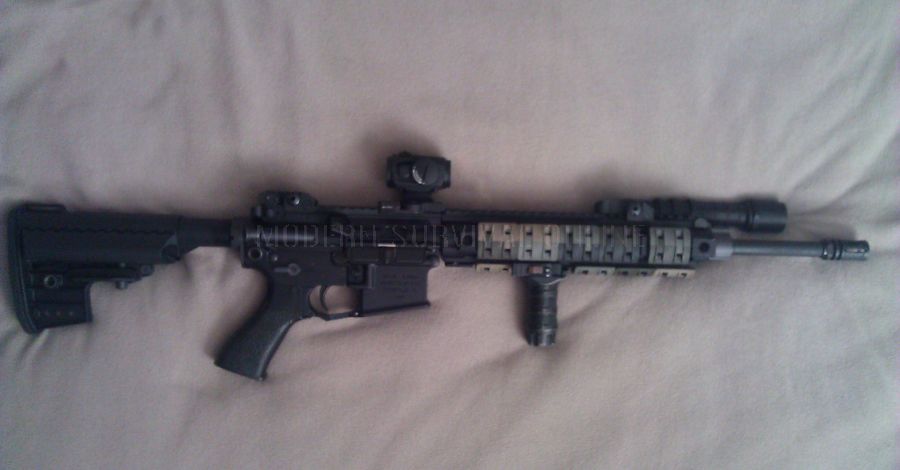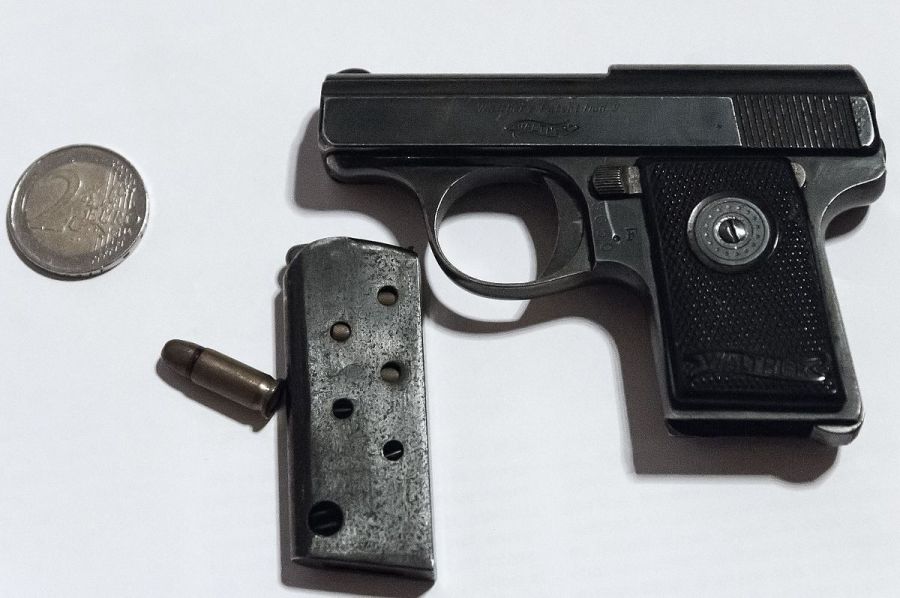by Charles
Most preppers know the AR-15 is America’s most popular rifle, and even more call on one or several of these excellent guns to serve as defensive or SHTF weapons. The AR-15 brings so many advantages to the table that the reductive method is often an easier conversation to have when selecting a rifle for protection: what does an AR not do well?
That’s a common argu-sation in preparedness circles. One you might not have heard but is no less spirited is not whether you should choose an AR, but which AR you should choose, and I don’t mean brand: I mean the long-running debate between the lean, 5.56mm shooting AR-15 and its beefy, 7.62mm slinging older brother, the AR-10.
These rifles share plenty of DNA, but their differences are deeper than just caliber. Each brings plenty to the table, definitely enough to merit selection for most of us, but what is perhaps more important is a nuanced understanding of the quirks and flaws inherent to each rifle. In today’s article, I’ll be opening up the conversation on both in detail, and offering you my opinion on which one is the better choice depending on your anticipated needs.
Foreword
When shooters discuss the AR platform outside of strict academic or historical context you’ll see these rifles dubbed AR-15 and AR-10 as a sort of shorthand: AR-15 denoting a rifle chambered in the classic 5.56x45mm cartridge and AR-10 denoting a rifle chambered in 7.62x51mm NATO or .308 Winchester.
Yes, today both families of rifle are available in myriad calibers, both standard, uncommon and wildcat, but for our discussion today I will be limiting my arguments to these two standard options, as they are both overwhelmingly the most commonly available, and chosen, and because both make the most sense from a logistical standpoint: you can get either cartridge anywhere and in quantity. That is important from most preppers’ perspectives.
Also, this article will not be chronicling the design, creation and adoption of the AR-10, AR-15 or any other brainchild of the late, great Eugene Stoner except as those design choices may affect your decision to purchase or equip yourself with one.
While extremely interesting reading, it will not add anything to our discussion of practical application and merit of either rifle, and that parcel of history on either rifle has been written about in detail elsewhere.
Lastly, my opinions on both are a product of my own, not inconsiderable experience. My own preferences and prejudices lean to adaptable, generalist solutions. My intent is to be at least passably prepared for as wide a spectrum of challenges as possible. Simply stated, you will rarely have need of a truly specialized tool, including guns, to solve your problem.
Ergo, I do not care much for unwieldy, long precision or sniper rifles for the same reason I do not like CQB carbines with itty-bitty 7” barrels: they are specialized tools that give up too much flexibility to shine in one tightly defined role. I prefer, and use, a 14” to 16” barreled carbine with either a RDS or LPVO, such a setup covering nearly all of my potential, plausible shooting scenarios with aplomb.
As a likely solo survivor or small-group/unit member, you will probably not be afforded the luxury of specialization. What you need is a high amount of general competency in multiple domains. This includes your tools.
Were I looking to survive as a member of a four man band, I would much rather us all be modestly cross trained in skills (and armed accordingly) than rely on one man as the driver, one as the medic and one as the wilderness guide.
Lastly, this is not a discussion of Brand X against Brand Y or Z. My intent with this article is to assess the AR-15 against the AR-10 as classes of rifle, not a Consumer Reports-esque head-to-head of different brands. I can save all of that for another article. Keep that in mind as you ponder my judgments.

photos: above, an Ar-15, below an AR-10

AR-10 vs AR-15: What’s the Big Difference?
Let’s get this sorted right up front. When referring to AR-15’s, shooters generally refer to a 5.56mm rifle, as mentioned above, and one that is direct-impingement operated, though piston is a less common but reasonably popular variation or modification.
Aside from this possible gas system difference and a few truly oddball or older production models, AR-15s are broadly identical internally from a design perspective: you can nominally swap upper receivers, magazines, bolt carrier groups, charging handles, fire control components, etc. and expect them to at least fit and assemble the gun.
AR-10s on the other hand are 7.62mm rifles, also usually direct-impingement operated, larger and heavier than the younger AR-15 in nearly every comparison. An AR-10 is not simply an AR-15 action up-gunned to a 7.62mm NATO barrel.
No sir, the upper and lower receivers are both of completely different specification, necessary to accommodate the drastically larger 7.62mm cartridge; the bolt and bolt carrier of an AR-10 appear downright massive next to the smaller AR-15’s BCG, and the upper receivers of these guns always have something of a portly look to them accordingly.
But furthermore and more important than differences in dimension, commercial AR-10s have been produced in a dizzying assortment of variations, using one of several “standard” or proprietary magazines, receiver specs, barrels, bolts etc. This means you cannot count on being able to poach parts or magazines and simply drop them on to your AR-10, since compatibility is almost always a question.
For instance, take a bread-and-butter component all shooters and preppers will stock in abundant quantities- magazines! Commercial AR-10’s have been produced using no less than 5 different magazines, though mercifully one pattern has started to pull away as one approximating a standard.
The original, real deal Armalite AR-10 uses (rather may use…) AR-10 magazines. The other most common pattern is the SR-25/LR-308 pattern magazine used by DPMS, Knight’s Armament Co. and a host of other rifles (and now also certain Armalite AR-10’s!).
magazines. The other most common pattern is the SR-25/LR-308 pattern magazine used by DPMS, Knight’s Armament Co. and a host of other rifles (and now also certain Armalite AR-10’s!).
If this sounds like some kind of messed-up VHS and Betamax deathmatch, you aren’t half wrong. Too make matters even worse, other manufacturers like Rock River Arms developed a 7.62 AR’s that used modified FAL magazines. Yikes! Makes you pine for plain ol’ AR-15 magazines, huh?
While we are starting to see some convergence by most manufacturers new production to take the SR-25/LR-308 pattern magazines thanks to Magpul offering their own 3rd party version, there are tons of guns out in the wild that use Armalite magazines. Now imagine that same conundrum for all the other parts of the rifle…
The First Consideration – Parts Compatibility
That essential difference brings us to our first point of contention between the two: From a logistical standpoint, this compatibility checking is something you must be aware of. If you are the kind of prepper who does not mind stocking everything you need ahead of time, and from one or two trusted sources, an AR-10 will just be another rifle for you.
If however you are the kind of prepper who likes to tinker, tune and experiment, an AR-10 is going to be a disappointment or a major headache without extensive knowledge of what parts fit which pattern of AR-10.
Likewise, in a long term sustainment scenario, an AR-15 shooter will correctly assume he can buy, source, pickup or scavenge parts for his rifle nearly anywhere. AR-10 shooters will not be so lucky: the rifles themselves are nowhere near as common or popular as AR-15s of any make and description, and assuming you do come across one in the wild it might be a bit of a crap shoot as to whether or not you can make use of parts from it.
In essence, the AR-15 as a family is far more forgiving and amicable to mix-and-match Frankenstein’ing of parts. The AR-10 family, not nearly as much. This will be a point of contention for some, and not for others: it is not an inherent flaw.
The Second Consideration – Cost
When considering the cost of a rifle, it is useful to establish what is expected from a rifle in a certain price point, but also what we are trying to achieve with that rifle. Based on my earlier clarification, we need a rifle that is as reliable as possible while also being reasonably accurate. I have written of on many occasions my strident advocacy of high-quality firearms.
High-quality guns cost more than guns of low grade, but if you are serious about ensuring your success you will choose the tools of the highest grade you can afford.
Without dissecting the definition of “afford” ad infinitum, let us be content with the fact that there with AR-15s there is a price threshold you can drop below where real quality is impossible. Similarly, you can spend far, far in excess of the median price of a good rifle and see only miniscule returns in performance over that expenditure. Essentially, you don’t need to spend a fortune but it is always worse to spend too little.
As an example, for an AR-15, you will have a broad choice of good rifles from good manufacturers anywhere between $1100-$1500, with a handful of truly solid rifles around $900. Much lower than that and you are delving into hobby-grade rifles; not ones you want to rely on.
For AR-10s you only begin to get into decent territory around $1350-$1500. High quality examples of the breed begin around $2000 and go up from there. There is one, perhaps two makes of rifle below the lower range that is even worth consideration. They are simply drastically more expensive to get into at a commensurate level of quality.
And more. Everything costs more when you are choosing an AR-10, from magazines and ammo, to spare parts, platform specific accessories and upgrades. This is simply the nature of the beast. Understand your dollars will go further when choosing an AR-15, all things being equal.
The Third Consideration – Performance
When assessing the performance difference between an equivalent AR-10 and AR-15, we must consider their mechanical performance and ballistic performance, owing to their significantly different chamberings. Let’s start with mechanical performance first.
ARs of all stripes run the gamut of mechanical reliability from Shur-Fine toasters that shoot minute-of-barn and barely run when they do, to Thrice-Blessed hair-splitters that are seemingly invincible. That being said, if you buy somewhere in the middle of the pack by price, you will probably have a rifle that is possessed of solidly good accuracy and dependable reliability.
All things being equal, both the AR-10 and AR-15 are capable of very good accuracy, especially with good load selection. Both are reliable when given even a little maintenance, but it must be said here that AR-10’s trend toward being a little fussier than AR-15’s. Maybe it is ammunition sensitivity or an narrower optimum operating band, but all of my experience with AR-10s across the board has given me a significant enough anecdotal sample size of data to convince me.
This is not to say AR-10’s are prissy or cannot be depended on in harsh conditions (though some lesser models can be), only that by my count, they are not quite as boringly dependable as their smaller brethren. Additionally, troubleshooting and repairing AR-10s is not quite as straightforward as it is with an AR-15.
Part of this is due to the aforementioned parts compatibility concerns, but the rest is simply the nature of the beast: spring rates, gassing, dwell time and more must all be in harmony to expect good function from any AR-10.
Regarding projectile performance, there has already been rivers of ink spilled about the 5.56mm and 7.62mm NATO. The 5.56 is light-recoiling, flat shooting and shows very good performance against soft targets, but struggles more with defeating harder materials and intermediate barriers. The average magazine capacity is 30, and the even loaded these magazines do not weigh very much.
The aging 7.62mm NATO produces stout recoil, incurs a significantly steeper trajectory and shows very good performance against soft targets and intermediate barriers, even light cover, especially with the benefit of modern projectiles. The average magazine capacity is 20, and they are significantly heavier and bulkier than AR-15 magazines in any form.
The 7.62 is often automatically thought the superior cartridge from both a long-range precision standpoint as well as when discussing wounding capability. This is not quite so clear cut as the layman believes, however.
The 7.62 certainly has advantages at long range compared to the 5.56: it maintains more momentum, is heavier and bucks wind better than the light 5.56, and with modern guns and ammo can be pushed past 1,000 yards, though for any civilian this is purely academic. For anti-personnel use the 7.62 will handily defeat barriers like automobile glass and bodywork, heavy clothing, light wood material and some masonry. It has much to commend it.
The 5.56 on the other hand struggles past its extreme range of 700-800 yards, and will have some difficulty dealing with wind even before that. Automobile glass and bodywork both significantly degrade the performance of most 5.56mm projectiles. It is however a consistently solid performer against people, contrary to the popular conception of most shooters.
But for my money, the biggest difference these calibers make for their users is simply one of trajectory: the 5.56mm is much flatter shooting than the 7.62mm, and because it is so much faster it makes holding for both lead and elevation a simpler affair all the way around at intermediate distance. Simply put, it makes getting hits at range easier, and don’t believe the detractors who would have you think a 5.56 is a mosquito bite at 300 yards.
The light recoil of the 5.56mm speeds up reacquisition of the sights shot to shot and reduces shooter fatigue. Both important practical considerations. The 7.62mm NATO’s best advantages lie in its use as a dedicated long range precision rig, which, while cool and certainly a great tool for someone with that mission set, are largely wasted for most citizens as a general purpose defensive and utility rifle.
Now, you certainly can make an argument for the 7.62mm as a better choice for someone who has concerns about shooting through the aforementioned materials as a matter of course. No one who is worried about routinely engaging through vehicles or other harder structures will choose a 5.56mm first.
You may also find the solidly all-around performance of a .30 caliber rifle comforting; even in a 16” carbine format an AR-10 makes a great rifle for defense and hunting all but the very largest of game. What you give up in handiness you gain in versatility somewhat.
Final Analysis
Below is my short and sweet list of perks and flaws I attribute to the AR-15 and AR-10 family of rifles as families, and after that I will add more of my own thoughts.
AR-15 variant, 5.56x45mm
+ Light
+ Less Expensive
+ Flat Shooting
+ Low Recoil
+ Parts largely interchangeable and easy to find
– 5.56 struggles at extended ranges
– 5.56 not best choice for large game or intermediate barriers
AR-10 variant, 7.62x51mm NATO
+ 7.62 shows very good penetration and performance against barriers and large game
+ 7.62 is better all-around performer at long range, though trajectory requires more practice to mitigate
– Rifles, parts and ammo significantly more expensive compared to AR-15
– Rifle and mags heavier
– Great variety of parts and types makes upgrades and repair more challenging for novice and average users.
So on the surface, it looks like you simply wind up paying more and giving up the svelte handling qualities of an AR-15 to get into that beefy, punchy 7.62mm club. If you kit-out an AR-10 and AR-15 identically, same optics, slings, lights, etc. and lay them side by side, you’ll be surprised at how close they are to each other in form factor. Pick them up though and you’ll definitely notice a difference in weight, though it may or may not be as extreme or intolerable as you may be thinking.
This weight differential will though come into sharp contrast when you start piling on ammo. Loaded mags of 7.62mm gobble up space and pounds compared to 5.56mm. Don’t forget this was one of the principal reasons the military adopted the then-new 5.56 back in the Vietnam War: the ammo was lighter and smaller. You may not be heading into a raging infantry battle but I guarantee you weight is a factor if you care about schlepping your BOB around half of creation.
But weight is not all there is to the equation. Plenty of shooters and preppers simply want the assurance and confidence that they have a round good at “long range.” Fine. But I would question what kind of ranges they are anticipating needing their rifle for in a serious emergency? 100 yards? Perhaps. 200 yards?
I could even envision that in a prolonged survival situation in the right area. 300 and beyond? Hardly plausible, and if you are talking about real extreme distance shooting you are dreaming unless you already have well-established long range skills as a sniper or long-range competition shooter.
No, you average distance for domestic shootouts, police or civilian involved, are nearly all within 100 yards, and the vast, vast majority are within 20 yards. If long guns are being brought to bear at those distances, a lighter, faster-handling rifle is more often the better choice.
Don’t misunderstand, I like AR-10s and have owned and used several examples. The good ones are reliable, accurate and dependable, and I surely like the performance of a .30 caliber round when I may need to punch thorough something with authority. But I still choose an AR-15 almost every single time, because it can do 99/100 things that may ever need my defensive rifle to do, no question.
The Bottom Line
Choose an AR-15. If you have to have an AR-10, and can afford a good one, you will not be making a terrible mistake, but for most users their greater expense is not justified by the only modest increase in projectile performance unless hunting large game or regular defeat of barriers is a concern of yours.
I would not feel under armed with either, but the AR-15 family brings the most advantages for the most people.
AR-10s and AR-15s are both valid choices for primary rifles as part of a comprehensive preparedness plan. But the ubiquity and lower costs of an AR-15 will often see it a smarter choice in light of an average prepper’s needs. The AR-10’s potent 7.62mm NATO round is attractive, but the greater expense, added weight and logistical concerns inherent to this class of rifle compared to the AR-15 mean it is one that must be chosen with deliberation and care.



 magazines. The other most common pattern is the SR-25/LR-308 pattern magazine used by DPMS, Knight’s Armament Co. and a host of other rifles (and now also certain Armalite AR-10’s!).
magazines. The other most common pattern is the SR-25/LR-308 pattern magazine used by DPMS, Knight’s Armament Co. and a host of other rifles (and now also certain Armalite AR-10’s!).














